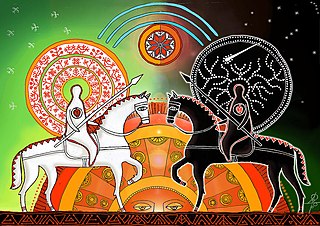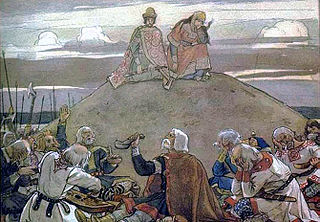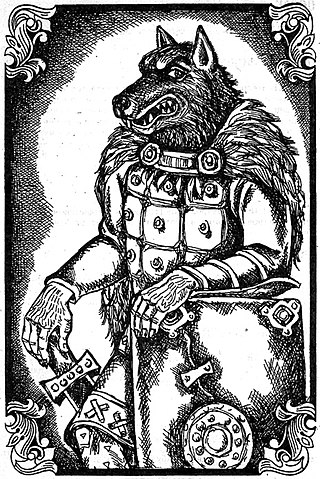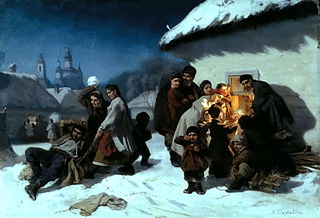Related Research Articles

Chernobog and Belobog are an alleged pair of Polabian deities. Chernobog appears in Helmold's Chronicle as a god of misfortune worshipped by the Wagri and Obodrites, while Belobog is not mentioned – he was reconstructed in opposition to Chernobog. Both gods also appear in later sources, but they are not considered reliable. Researchers do not agree on the status of Chernobog and Belobog: many scholars recognize the authenticity of these theonyms and explain them, for example, as gods of good and evil; on the other hand, many scholars believe that they are pseudo-deities, and Chernobog may have originally meant "bad fate", and later associated with the Christian devil.
In Slavic mythology, notsnitsa, often referred in plural, is a nightmare spirit or demon that torments people and especially children at night. Other names for notsnitsa in East Slavic languages include kriksy, plaksy, plachky, plaksivicy, kriksy-varaksy, kriksy-plaksy, night hag, night maiden.

In Slavic folklore, the raskovnik or razkovniche is a magical herb. According to lore, the raskovnik has the magical property to unlock or uncover anything that is locked or closed. However, legends claim it is notoriously difficult to recognize the herb, and reputedly only certain chthonic animals are able to identify it.
Cikavac is a mythical creature in Serbian mythology, imagined as a winged animal with long beak and a pelican-like sack.
Bukavac is a demonic mythical creature in Slavic mythology. Belief in it existed in Syrmia.
Stuhać is a demonic mythical creature in Serbian mythology, recorded in Herzegovina. Though its name is similar with zduhać, there is no actual similarity.

A zduhać and vetrovnjak in Serbian tradition, and a dragon man in Bulgarian, Macedonian and southern Serbian traditions, were men believed to have an inborn supernatural ability to protect their estate, village, or region against destructive weather conditions, such as storms, hail, or torrential rains. It was believed that the souls of these men could leave their bodies in sleep, to intercept and fight with demonic beings imagined as bringers of bad weather. Having defeated the demons and taken away the stormy clouds they brought, the protectors would return into their bodies and wake up tired.

An ala or hala is a female mythological creature recorded in the folklore of Bulgarians, Macedonians, and Serbs. Ale are considered demons of bad weather whose main purpose is to lead hail-producing thunderclouds in the direction of fields, vineyards, or orchards to destroy the crops, or loot and take them away. Extremely voracious, ale particularly like to eat children, though their gluttony is not limited to Earth. It is believed they sometimes try devouring the Sun or the Moon, causing eclipses, and that it would mean the end of the world should they succeed. When people encounter an ala, their mental or physical health, or even life, are in peril; however, her favor can be gained by approaching her with respect and trust. Being in a good relationship with an ala is very beneficial, because she makes her favorites rich and saves their lives in times of trouble.

Trizna was a funeral feast of ancient Slavic religion, which was conducted for distinguished members of society before their cremation. Besides the feast and the wake, the deceased will have their body washed and dressed in the finest clothes before their cremation, and merry-making and contests were also held. According to tradition, this was done to symbolise the victory of life over death by repelling evil spirits with laughter.

Psoglav is a demonic mythical creature in Balkan mythology; belief about it existed in parts of Bosnia and Montenegro. Psoglav was described as having a human body with horse legs, a dog's head with iron teeth, and a single eye on the forehead.
Crazy Vuk's border, sometimes also called Dukljan's border is remains of a border wall in Montenegro. It follows the line Dubrovnik-Bijela gora -Cuce-Čevska planina-Ostrog-Razbijeni vrh (Bjelopavlići)-Donja Morača-Kom.
Dukljan or Dukljanin is a figure in Serbian mythology that is a reflection of the Roman emperor Diocletian. He is presented as the adversary of God, possibly because of the real Diocletian's persecution of Christians.
This article describes Serbian folk astronomy.
Serbian Christmas traditions are customs and practices of the Serbs associated with Christmas and a period encompassing it, between the third Sunday before Christmas Day and Epiphany. There are many, complex traditions connected with this period. They vary from place to place, and in many areas have been updated or watered down to suit modern living. The Serbian name for Christmas is Božić, which is the diminutive form of the word bog ("god"), and can be translated as "young god". Christmas is celebrated for three consecutive days, starting with Christmas Day, which the Serbs call the first day of Christmas. On these days, one is to greet another person by saying "Christ is Born," which should be responded to with "Truly He is Born," or in Serbian: "Hristos se rodi" – "Vaistinu se rodi".
In Serbian, Macedonian and in Bulgarian mythology, Black Arab is a designation for Arabs and black people. The Black Arab is often depicted as a dark skin ruffian who kidnaps women and girls. In Serbian folklore, as well as in the beliefs of other Balkan peoples, the Arab is a chthonic demon, a replacement for the devil. Some authors compare it with Slavic Triglav.
The Serbs have many traditions. The Slava is an exclusive custom of the Serbs, each family has one patron saint that they venerate on their feast day. The Serbian Orthodox Church uses the traditional Julian Calendar, as per which Christmas Day falls currently on January 7 of the Gregorian Calendar, thus the Serbs celebrate Christmas on January 7, shared with the Orthodox churches of Jerusalem, Russia, Georgia, Ukraine and the Greek Old Calendarists.

Koliadari are Slavic traditional performers of a ceremony called celebration of Koliada, a kind of Christmas caroling. It is associated with Koliada (Calends), a celebration incorporated later into Christmas.
Bauk is an animal-like mythical creature in Serbian mythology. The bauk is described as hiding in dark places, holes, or abandoned houses, waiting to grab, carry away, and devour its victim; but it can be scared away by light and noise. It has a clumsy gait (bauljanje), and its onomatopea is bau.
Miroč is a mountain in eastern Serbia, between the towns of Donji Milanovac and Tekija. Its highest peak Štrbac has an elevation of 768 meters (2,520 ft) above sea level. Along with Liškovac, it is part of the Iron Gate gorge of the Danube river. It is located in the Đerdap national park.
Čuma or kuga is the personification of plague in Serbian mythology. It was imagined as an old woman dressed in white. Mentioning čuma was avoided, so euphemisms kuma (godmother) or teta (aunty) were used.
References
- ↑ Levi, Pavle (2007). Disintegration in frames : aesthetics and ideology in the Yugoslav and post-Yugoslav cinema. Stanford, Calif.: Stanford University Press. ISBN 978-0-8047-5368-5. OCLC 71581809.
- 1 2 3 4 5 6 7 8 9 10 11 12 13 Š. Kulišić; P. Ž. Petrović; N. Pantelić (1970). "Дрекавац". Српски митолошки речник (in Serbo-Croatian). Belgrade: Nolit. p. 110.
- 1 2 "Gimnastika na poledici". Nezavisna Svetlost #216. 1999. Archived from the original on 2008-04-09.
- 1 2 Z. Šaponjić (2003-10-20). "I drekavac sumnjiv". Glas Javnosti (in Serbo-Croatian). Retrieved 2006-09-22.
- ↑ "Ljudi i vreme".
- ↑ Ćopić, Branko. "Hrabri Mita i drekavac iz rita". U svijetu medvjeda i leptirova. Archived from the original on 2007-01-28. Retrieved 2007-05-01.
- ↑ Ćopić, Branko. "Chapter I". Orlovi rano lete. Archived from the original on 2007-09-28. Retrieved 2007-05-01.
- ↑ Correia, Larry (2021). Monster hunter bloodlines. Riverdale, NY. ISBN 978-1-9821-2549-3. OCLC 1251738232.
{{cite book}}: CS1 maint: location missing publisher (link) - ↑ "Dissension Sortable Spoiler". Wizards of the Coast. Archived from the original on April 24, 2006. Retrieved 2007-05-01.
- ↑ "Drekavac iz vira". Izvorimagije.com. Retrieved 2007-05-01.
- ↑ Š. Kulišić; P. Ž. Petrović; N. Pantelić (1970). "Букавац". Српски митолошки речник (in Serbo-Croatian). Belgrade: Nolit. p. 48.
- ↑ Š. Kulišić; P. Ž. Petrović; N. Pantelić (1970). "Јауд". Српски митолошки речник (in Serbo-Croatian). Belgrade: Nolit. p. 157.
- ↑ Š. Kulišić; P. Ž. Petrović; N. Pantelić (1970). "Плакавац". Српски митолошки речник (in Serbo-Croatian). Belgrade: Nolit. p. 236.